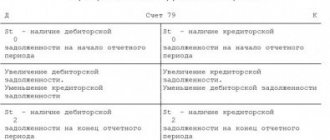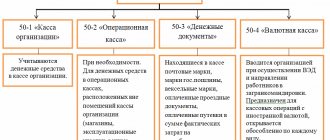Trademark or trademark
There is no definition for such a concept as a “trademark” in our legislation. As a rule, it is understood as an element of individualization of any product or company that is not protected from a legal point of view. In fact, this is just a term for marketers, which is applied to such concepts as a trademark, trade names, etc. A trademark is represented by some kind of image, a combination of letters or an original name. If the organization that created the trademark decides to register the trademark in the state register, then it will be the exclusive copyright holder of the trademark. That is, a trademark is an already legally protected element of individualization of a company or product. The right to a mark is confirmed by a special certificate.
Renewal of trademark rights
Situation: how to reflect in the accounting of the copyright holder organization the costs of extending the validity period of the exclusive right to a trademark?
The procedure for reflection in accounting depends on the period for which the exclusive right to a trademark is extended.
If the contract is extended for a period of less than 12 months, then reflect the one-time fixed payment for extending the term of the exclusive right to a trademark on account 97 “Deferred expenses”. This conclusion follows from paragraph 19 of PBU 10/99, paragraph 65 of the Regulations on Accounting and Reporting, Instructions for the Chart of Accounts (account 97).
Costs taken into account as deferred expenses begin to be written off immediately after the exclusive right to use the trademark has been extended. Establish the procedure for writing off expenses yourself and establish it in the accounting policy for accounting purposes (clauses 7 and 8 of PBU 1/2008). For example, a one-time one-time payment can be written off evenly over the period for which the right of use is extended.
Reflect the one-time payment for renewal of the exclusive right to use a trademark using the following entries:
Debit 60 (76) Credit 51
– a one-time fixed payment is transferred for extending the validity period of the exclusive right to a trademark;
Debit 97 Credit 60 (76)
– a fixed one-time payment for the renewal of the exclusive right to use a trademark is taken into account;
Debit 19 Credit 60 (76)
– VAT is reflected on expenses associated with the extension of the exclusive right to use a trademark.
Record the write-off of expenses for current expenses by posting:
Debit 20 (23, 25, 26, 44...) Credit 97
– expenses for extending the validity period of the exclusive right to a trademark are written off.
If the contract is extended for a period of 12 months or more, then in accounting the costs of renewing the exclusive right to a trademark are taken into account as a new intangible asset in the general manner.
The procedure for recognizing intangible assets
In order for an object to be accepted for accounting as an intangible asset, the following conditions must be met:
- An object accepted for accounting must bring economic benefit to the organization in the future. An object is considered economically profitable if it is intended either for the production of products or for the management needs of the company. The trademark meets this requirement, that is, it is capable of bringing benefits to the organization in the future;
- The company has the right to receive economic benefits; a limited number of persons have access to such benefits. This condition can only be applied to a trademark; it is not always applied to a trademark. If the exclusive rights to a trademark are not registered, then any other company has the right to use a similar individualization mark. And having registered such a mark with Rospatent, such an organization has the right to file a claim to protect its rights. That is, a third party will control the asset. The presence of legal rights to intangible assets is not a mandatory criterion for recognition of an asset in accounting, but their presence may limit the access of other persons to the economic benefits from the use of this intangible asset;
- The object can be identified. An asset meets this condition if it is separable, that is, it can be sold, exchanged, etc., and also if it arises as a result of legal rights, regardless of whether these rights are transferred or separate from the organization;
- The object is intended for long-term use (more than 1 year);
- The sale of the property is not expected in the coming year;
- The cost of the object can be reliably determined;
- The object has no material form.
| ★ Best-selling book “Accounting from scratch” for dummies (understand how to do accounting in 72 hours) > 8,000 books purchased |
Trademarks: accounting and taxation
Stake out a name
The definition of a trademark and the procedure for its circulation are established by the Civil Code.
Thus, Article 1477 of the Code states that a trademark is a designation that serves to individualize the goods of both companies and individual entrepreneurs. However, do not confuse trademarks and service marks. Although they are essentially identical, they perform different functions. Namely: trademarks serve to individualize goods, and service marks serve to recognize the work performed or services provided. The right to a trademark must be certified by a certificate. In this case, a certificate is issued only if the trademark is registered in the State Register of Trademarks. The executive body that carries out such registration is Rospatent. Therefore, he also establishes the rules for drawing up, submitting and considering an application for registration of a trademark (Order of Rospatent dated March 5, 2003 No. 32). A properly executed certificate is valid throughout the entire territory of our country and certifies the priority of the trademark and the exclusive right to it. It also provides legal protection (Article 1225 of the Civil Code). But legal protection only applies to the goods specified in the certificate.
A trademark can be registered in any form: verbal, figurative or combined. But at the same time, the newly developed symbol must be such that it cannot be confused with a previously registered brand.
The exclusive right to a trademark is valid for 10 years from the date of filing an application for state registration (clause 1 of Article 1491 of the Civil Code). In this case, the registration period can be extended for another 10 years. And such an extension is possible an unlimited number of times. But if a registered trademark is not used continuously for 3 years from the date of its registration, then its legal protection may be terminated early (clause 1 of Article 1486 of the Civil Code). Moreover, an application for non-use of a trademark can be filed by any interested party, including a competitor.
Accounting for your own trademark
A trademark refers to intangible assets (IMA) - both for accounting and tax purposes. It does not matter how it was obtained: developed by the company itself or ordered externally, purchased for a fee from the copyright holder or received as a gift. The main thing is that such an enterprise has documents confirming both the existence of the trademark itself and the ownership of it. In addition, the company that owns the trademark must be able to control it, which, accordingly, means control over the use of the brand. After all, only in this case the company has the right to receive economic benefits from the use of such an instrument (stimulator of consumer demand). And obtaining economic benefits is one of the main criteria by which an asset can be classified as an intangible asset (subclause b, clause 3 of PBU 14/2007 “Accounting for intangible assets”, approved by order of the Ministry of Finance dated December 27, 2007 No. 153n). But the ability to receive economic benefits from the use of an asset is a mandatory condition in order to classify it as an intangible asset, but not sufficient. All other conditions are also listed in subparagraph b of paragraph 3 of PBU 14/2007. Among them are, for example, the following: the ability to bring economic benefits in the future; intended for use over 12 months, during which it is not intended to be sold; absence of a material form. If all of the above conditions are met, then the resulting trademark can be classified as intangible assets (clause 4 of PBU 14/2007). Otherwise, it cannot be considered an intangible asset. But then another question arises: is such an asset a trademark? It should be noted that the same requirements for intangible assets are imposed by tax legislation (clause 3 of Article 257 of the Tax Code).
A trademark is accepted for accounting at its actual cost, which consists not only of the costs of its acquisition or creation, but also of the costs associated with ensuring the conditions for using such an object for the intended purposes (clause 8 and clause 9 of PBU 14/2007). But not all expenses incurred can be taken into account in the initial cost of the trademark. Thus, VAT and other refundable amounts of taxes are not subject to inclusion in the cost of the sign, unless otherwise provided by law. For example, the trademark will be used in activities not subject to VAT. In this case, the tax will participate in the formation of its value (clause 2 of Article 170 of the Tax Code). In addition, interest on loans and credits received does not increase the value of the trademark. Interest on borrowed funds in accounting is classified as other expenses, and for tax purposes - as non-operating expenses.
When a trademark is accepted for registration, an intangible asset registration card is issued for it in form No. NMA-1. It is also necessary to draw up an act for putting it into operation. The unified form of such an act is not approved by the State Statistics Committee, so the company can develop the form of this document independently, approving it in the accounting policy. The main thing is that it contains all the necessary details specified in paragraph 2 of Article 9 of the Law of November 21, 1996 No. 129-FZ “On Accounting”. It is the execution of these documents that indicates the acceptance of the trademark for registration. And this is a direct path to deducting VAT on all costs associated with the development and registration of a trademark (clause 1 of Article 172 of the Tax Code). And don’t forget: a trademark will be considered as such only after receiving a certificate from Rospatent.
Simultaneously with the acceptance of a trademark for registration, it is necessary to determine its useful life - the period expressed in months during which the mark can be used. Moreover, it is not used just like that, but for the purpose of obtaining economic benefits. This is not difficult to do. After all, the validity period of the certificate is established by law: 10 years from the date of filing the application for registration. This means that the validity period of the certificate should simply be reduced by the waiting period from the date of filing the application until the issuance of the document of protection.
The cost of the trademark is gradually written off as expenses through depreciation. A trademark that has been put into use can begin to be depreciated from the next month after the start of its use. There are several ways to calculate depreciation charges. But it is best to choose linear. Then there will be no differences in accounting for depreciation amounts for both accounting and tax purposes.
But trademark registration does not always go smoothly; sometimes Rospatent refuses to recognize a new brand. In this case, the company will not have a new asset, and the costs for it will not reduce profits, since they are not economically justified.
It happens that a company wants to enter international markets and registers its trademark in other countries. Although such registration is not a “cheap pleasure” and will be valid for several years, it will not have an impact on the value of the trademark. After all, after a trademark is accepted for registration, its initial value can no longer change (clause 16 of PBU 14/2007). This rule also applies for tax purposes. Therefore, expenses for international brand registration should be considered as expenses for ordinary activities (letter of the Ministry of Finance dated August 2, 2005 No. 03-03-04/1/124).
Example 1
Iceberg LLC is engaged in the production of refrigeration equipment. In order to increase the competitiveness of its products, the company's management decided to create its own trademark. Therefore, an agreement was concluded with a consulting firm to receive recommendations on how to apply your brand. The cost of consulting services amounted to 47,200 rubles, including VAT - 7,200 rubles. In addition, Iceberg LLC commissioned the design bureau to develop a trademark. The cost of designer services is 35,400 rubles, including VAT - 5,400 rubles. Once the brand was developed, the company applied for trademark registration and examination of the applied designation. A patent fee of 8,500 rubles was paid for filing the application. After the examination of the application, the company paid a patent fee in the amount of 10,000 rubles. for registration and issuance of a certificate. The entire trademark registration process took 6 months.
The following entries were made in the company's accounting records:
Debit 08 Credit 60 - 40,000 rub. — a report was received from a consulting firm on the procedure for using the brand;
Debit 19 Credit 60 - 7200 rub. — reflects the amount of VAT presented by the consultant;
Debit 60 Credit 51 - 47,200 rub. — paid for the services of a consulting company;
Debit 08 Credit 60 - 30,000 rub. — design bureau developed a trademark;
Debit 19 Credit 60 - 5400 rub. — the amount of VAT presented by the designers is reflected;
Debit 60 Credit 51 - 35,400 rub. — paid services for the development of a trademark;
Debit 76 Credit 51 - 18,500 rub. (RUB 8,500 + RUB 10,000) — patent fees for filing an application, examination and issuance of a certificate have been paid;
Debit 08 Credit 76 - 18,500 rub. — patent duties are attributed to the increase in the initial cost of the trademark;
Debit 04 Credit 08 - 88,500 rub. (40,000 rubles + 30,000 rubles + 18,500 rubles) - the trademark was put into operation;
Debit 68 Credit 19 - 12,600 rub. (RUB 7,200 + RUB 5,400) — VAT submitted by consultants and designers is accepted for deduction.
Once a trademark is accepted for accounting, it can be depreciated. The useful life of a registered mark is 114 months. (10 years × 12 months – 6 months).
Debit 20, 44 Credit 05 - 776.32 rub. (RUB 88,500: 114 months) - depreciation was accrued on the trademark.
Depreciation will be calculated monthly in both accounting and tax accounting. In addition, it will reduce profits. If the trademark ceases to fulfill its function, then depreciation cannot be taken into account when calculating the tax base.
Upon expiration of the certificate, the company can apply for its renewal. In this case, the costs of extending the term of ownership of a trademark will be taken into account as deferred expenses (clause 18, clause 19 of PBU 10/99, approved by order of the Ministry of Finance dated May 6, 1999 No. 33n). Therefore, they will be gradually written off to cost over the next 10 years. Likewise, such expenses will reduce profits (clause 1 of Article 272 of the Tax Code).
Obtaining a trademark for use
Some companies prefer not to register their trademark, but to use someone else’s. After all, your own label requires significant promotion costs, while some brands are quite recognizable. To be able to use someone else’s trademark in your business, you must conclude a commercial concession agreement with its owner (licensor) (Clause 1 of Article 1027 of the Civil Code). But when concluding such an agreement, the potential user of the mark (licensee) must be prepared for the fact that he will have to ensure the conformity of the quality of the goods produced on the basis of the agreement. Moreover, the quality of the product must correspond not to its internal standards, but to the standards of the licensor (Article 1032 of the Civil Code).
A commercial concession agreement must be registered with Rospatent. If this is not done, the agreement will be considered void (clause 2 of Article 1028 of the Civil Code). This means no right to use the brand. And, as a result, the so-called licensee will not be able to reduce profits on payments made under such an agreement (clause 1 of Article 252 of the Tax Code). And problems with VAT will also appear: it will not be able to be offset. It is also impossible to reduce profits by amounts paid to the licensor before the conclusion of the contract. In this case, as a general rule, it is the copyright holder who is obliged to ensure proper registration of the concession agreement. Unless, of course, the contract provides otherwise (clause 2 of Article 1031 of the Civil Code).
Trademarks received for use are taken into account by the licensee on an off-balance sheet account in an assessment determined based on the amount of remuneration established in the agreement (clause 39 of PBU 14/2007). Please note that the chart of accounts does not provide for a separate account for accounting for intangible assets received, so the company must enter it independently, having approved it in the accounting policy. For example, account 012 is “Intangible assets received for use.”
The amount of remuneration, as a rule, consists of two parts: one-time and permanent, paid monthly during the term of the contract. The one-time payment is accounted for as deferred expenses and is written off gradually (clause 39 of PBU 14/2007). Profits are also gradually decreasing (clause 2 of Article 272 of the Tax Code). Periodic payments are reflected as expenses for the period in which they are accrued under the contract (clause 39 of PBU 14/2007) and reduce profit as other expenses associated with production and sales (subclause 37, clause 1, article 264 of the Tax Code).
Example 2
Zvezdochka LLC entered into a commercial concession agreement for the right to use the Sozvezdie CJSC trademark. The contract period is 5 years (60 months). Zvyozdochka LLC is responsible for registering the agreement. The fee for registering the contract is 8,000 rubles. The licensor's remuneration under the agreement is: a one-time payment - 590,000 rubles, including VAT - 90,000 rubles, and a monthly payment - 70,800 rubles, including VAT - 10,800 rubles.
The following entries were made in the licensee's accounting:
Debit 76 Credit 51 - 8000 rub. — the patent fee for registration of the agreement has been paid;
Debit 012 - 4,100,000 rub. (RUB 500,000 + RUB 60,000 × 5 years × 12 months) - the acquired right to use the trademark is reflected on the balance sheet;
Debit 97 Credit 76 - 8000 rub. — patent fees are charged to deferred expenses;
Debit 60, 76 Credit 51 - 590,000 rub. — a one-time payment is transferred;
Debit 19 Credit 60, 76 - 90,000 rub. — VAT is reflected on the amount of a one-time payment;
Debit 97 Credit 60, 76 - 500,000 rub. — a one-time payment is included in deferred expenses;
Debit 68 Credit 19 - 90,000 rub. — VAT is credited from the one-time payment amount;
Debit 20, 44 Credit 60, 76 - 60,000 rub. — monthly payment accrued;
Debit 19 Credit 60, 76 - 10,800 rub. — VAT is reflected on the monthly payment amount;
Debit 20, 44 Credit 97 - 8466.67 rub. ((8000 rub. + 500,000 rub.) : 60 months) - taken into account
part of deferred expenses.
O. Cherevadskaya , Head of the General Audit Department of JSC AK "BUSINESS PROFILE"
PRACTICAL ENCYCLOPEDIA OF AN ACCOUNTANT Everything an accountant needs to do bookkeeping. Everything will be found.
Connect berator
Inventory object
As an inventory object, intangible assets are recognized as a set of rights that arise from a patent, certificate or agreement on the alienation of the exclusive right to any means of individualization. Also, a complex object that includes several results of intellectual activity can be recognized as an inventory asset. Examples include a movie, a single technology, or a theatrical performance.
If, when creating one trade mark, an organization registers several means (trademark, service mark, etc.), then it is better to recognize intangible assets for each object.
Exclusive rights
In accounting, exclusive rights to a trademark (service mark), invention (utility model, industrial design) are taken into account as part of intangible assets if the following conditions are simultaneously met:
- the organization is the holder of exclusive rights to a particular object;
- the organization does not plan to sell (transfer) exclusive rights within the next 12 months;
- an object of intellectual property is used in the production of products (works, services) or for management needs;
- the use of the object can bring economic benefits (income);
- the period of use of the intellectual property exceeds 12 months;
- The organization can separate this asset from others and determine its actual (original) cost.
This is stated in paragraph 3 of PBU 14/2007. There are no cost restrictions for recognizing the exclusive right to an object of intellectual property as part of intangible assets in accounting.
Include exclusive rights to an object of intellectual property as part of intangible assets at their original cost (clause 6 of PBU 14/2007). The procedure for its formation depends on how the organization acquired these rights.
If the organization acquired exclusive rights for a fee, include all costs associated with the acquisition in the initial cost. Namely:
- amounts paid under the agreement of assignment (acquisition) of rights to the copyright holder (seller);
- the amount of the fee paid in connection with the registration of exclusive rights;
- the amount of VAT claimed (in cases where the use of the object in activities subject to this tax is not planned);
- other costs associated with the acquisition of exclusive rights (for example, the cost of information and consulting services, intermediary fees, customs duties, etc.).
Also, these expenses can be included in the initial cost of the asset if they arose when the asset was received under a gift agreement, barter, or as a contribution to the authorized capital.
This is stated in paragraphs 8 and 15 of PBU 14/2007.
The initial cost of exclusive rights obtained under barter agreements (exchange agreements) is the cost of the ordinary sale of the property transferred in exchange. If the value of the transferred property cannot be determined, then take into account exclusive rights at the price of their possible acquisition. This procedure is provided for in paragraph 14 of PBU 14/2007.
Advice : if an organization finds it difficult to value property transferred to a counterparty under a barter agreement (exchange agreement), apply the procedure that is used to determine market prices for tax purposes (Article 105.3 of the Tax Code of the Russian Federation). Firstly, it is spelled out in more detail. And secondly, this approach will avoid the difference between the initial cost of the object in accounting and tax accounting.
If the exclusive rights were received under a gift agreement, then form the initial cost taking into account the market valuation of the exclusive rights. Determine the market valuation on the date of receipt of the asset. The market price in this case is the amount of money that can be received by selling this asset. This value can be determined based on expert assessment. Such rules are established by paragraph 13 of PBU 14/2007.
If an organization has received exclusive rights as a contribution to the authorized capital, when forming their initial value, take into account the monetary value of the contribution agreed upon by the founders (participants, shareholders) (clause 11 of PBU 14/2007). This indicator should not exceed the market value of the property, determined by an independent appraiser:
- in joint stock companies;
- in an LLC, if the participant’s share in the authorized capital, which is paid for with exclusive rights, exceeds 20,000 rubles.
This procedure follows from the provisions of paragraph 3 of Article 34 of the Law of December 26, 1995 No. 208-FZ and paragraph 2 of Article 15 of the Law of February 8, 1998 No. 14-FZ. In these cases, an independent assessment of property contributions to the authorized capital is mandatory.
If an organization has created an object of intellectual property (trademark, invention (utility model, industrial design)) on its own, include all costs associated with the development in the initial cost of exclusive rights. Namely:
- expenses for services and work of third parties;
- salaries of employees directly involved in the development;
- contributions for compulsory pension (social, medical) insurance and insurance against industrial accidents and occupational diseases;
- expenses for maintaining fixed assets (other property) and intangible assets used to create a new asset, as well as depreciation amounts accrued on them;
- non-refundable taxes and fees;
- government, patent and other similar duties;
- customs duties and fees;
- other similar expenses.
Also, these expenses can be included in the initial cost of the asset if they arose when receiving the asset under a gift agreement, barter, or as a contribution to the authorized capital.
This is stated in paragraphs 8, 9 and 15 of PBU 14/2007.
Do not include the following expenses in the initial cost of an intangible asset:
- amounts of refundable taxes (for example, VAT);
- general business and similar expenses, except when they are directly related to the acquisition or creation of an asset;
- R&D expenses that were recognized in previous periods as other income and expenses;
- interest on loans and borrowings, except for the case when money is raised to create an investment asset.
Such rules are established by paragraph 10 of PBU 14/2007.
For each object of exclusive rights, fill out a card according to form No. NMA-1, approved by Rosstat Resolution No. 71a of October 30, 1997.
In accounting, reflect the costs of acquiring exclusive rights in account 08-5 “Acquisition of intangible assets.” If a trademark (invention, utility model, industrial design) is created on your own, account for the costs in a separate sub-account opened to account 08. This is explained by the fact that the Chart of Accounts does not provide for a special sub-account to reflect such expenses. An additional subaccount can be called, for example, “Creation of intangible assets.” Make the following wiring:
– in correspondence with account 60 “Settlements with suppliers and contractors” or 76 “Settlements with various debtors or creditors” - if the exclusive right was acquired for a fee or under a barter agreement (exchange agreement):
Debit 08-5 Credit 60 (76...)
– expenses for the acquisition of exclusive rights are reflected;
Debit 19 Credit 60 (76)
– VAT is reflected on costs associated with the acquisition of exclusive rights;
– in correspondence with account 98 “Deferred income” – if the exclusive right was received under a gift agreement:
Debit 08-5 Credit 98-2
– reflects the market value of the exclusive rights received under the gift agreement;
– in correspondence with account 75 “Settlements with founders” – if exclusive rights were received as a contribution to the authorized capital:
Debit 08-5 Credit 75-1
– reflects the value of exclusive rights received as a contribution to the authorized capital;
– in correspondence with cost and settlement accounts – if the organization created the intellectual property object independently:
Debit 08 subaccount “Creation of intangible assets” Credit 10 (60, 76, 68, 69, 70...)
– the costs of creating an intellectual property object are taken into account;
Debit 19 Credit 60 (76)
– VAT is reflected on costs associated with the creation of an intellectual property object.
The cost of exclusive rights to an object of intellectual property accepted on the balance sheet should be reflected in account 04 “Intangible assets”. In this case, do the wiring:
Debit 04 Credit 08-5 (08 subaccount “Creation of intangible assets”)
– exclusive rights to an object of intellectual property are taken into account as part of intangible assets.
The cost of exclusive rights recorded as part of intangible assets for which the useful life has been determined is written off through depreciation (clause 23 of PBU 14/2007). Start accruing depreciation from the next month after the reflection of exclusive rights on account 04 (clause 31 of PBU 14/2007).
If the conditions for recognizing intellectual property objects as intangible assets are not met (for example, an organization has received exclusive rights to an invention for temporary use), take them into account in the same manner as non-exclusive rights: as part of deferred expenses or in current expenses (clause. 38, 39 PBU 14/2007 and clause 18 PBU 10/99).
Basic postings
| Business transaction | Debit | Credit |
| The costs of developing a trademark are reflected | 08 | 70,69,60 |
| The trademark has been accepted for registration | 04 | 08 |
| Depreciation accrued | 20 | 05 |
| Depreciation written off upon disposal | 05 | 04 |
| The amount of additional valuation of intangible assets is reflected | 04 | 83 |
| Correction of the amount of depreciation of intangible assets upon revaluation | 83 | 05 |










